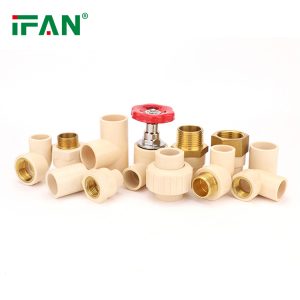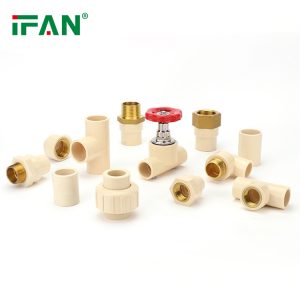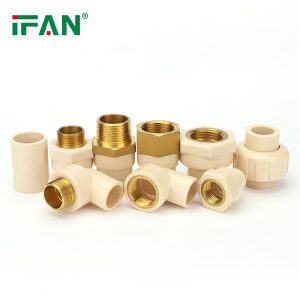Description
IFAN factory 30+ years manufacture experience support color /size customization support free sample.Welcome to consult for catalog and free samples.This is our Facebook Website:www.facebook.com,Click to watch IFAN’s product video.Compared with Tomex products, our IFAN products from quality to price are your best choice, welcome to buy!
Introduction
CPVC (Chlorinated Polyvinyl Chloride) fittings are increasingly gaining popularity in the construction industry due to their numerous benefits, including durability, cost-effectiveness, and versatility. One of the most important advantages of CPVC fittings is their positive impact on the environment. As sustainable construction practices become more important, many builders and contractors are turning to CPVC fittings for their eco-friendly properties. In this article, we will explore the various environmental benefits of using CPVC fittings in construction.
1. Reduced Carbon Footprint
When it comes to sustainability, one of the key factors to consider is the carbon footprint of the materials used in construction. CPVC fittings have a relatively low carbon footprint compared to other materials such as metal and PVC (Polyvinyl Chloride). The production of CPVC requires less energy and raw materials, resulting in fewer greenhouse gas emissions. This makes CPVC fittings a more eco-friendly option for building projects that aim to reduce their environmental impact.
2. Durability and Longevity
CPVC fittings are known for their exceptional durability and long lifespan. They are resistant to corrosion, which means that they will not degrade over time due to exposure to water, chemicals, or environmental factors. As a result, CPVC fittings require fewer replacements over the life of a building, reducing the need for new materials and the associated environmental impact of production and transportation.
Moreover, the extended lifespan of CPVC fittings helps reduce waste, as they do not need to be replaced as frequently as other materials like metal or PVC. This contributes to lower levels of construction waste, which is a significant issue in the industry.
3. Energy Efficiency
Energy efficiency is a crucial consideration in sustainable construction. CPVC fittings contribute to improved energy efficiency in plumbing systems by providing better insulation than traditional metal pipes. The superior insulation properties of CPVC help reduce heat loss in hot water pipes, thereby reducing the energy required to maintain desired water temperatures. This can lead to lower energy consumption in buildings, reducing overall energy costs and contributing to environmental sustainability.
Additionally, CPVC’s insulating properties help maintain the temperature of the water flowing through the pipes, reducing the need for excessive energy usage to heat water. This translates to reduced energy consumption, making CPVC an environmentally friendly choice for plumbing systems in both residential and commercial buildings.

4. Recyclability
Another environmental benefit of CPVC fittings is their recyclability. CPVC is a thermoplastic material, which means that it can be melted down and reprocessed without losing its quality or strength. This makes it possible to recycle CPVC fittings at the end of their useful life, reducing the amount of waste that ends up in landfills. As recycling technology improves, more CPVC fittings are being diverted from landfills, contributing to a circular economy in the construction industry.
Recycling CPVC fittings helps reduce the demand for new raw materials and lowers the environmental impact of manufacturing new pipes and fittings. By choosing CPVC, builders and contractors can contribute to reducing construction waste and supporting recycling initiatives.
5. Non-Toxic and Safe for the Environment
One of the key environmental advantages of CPVC fittings is that they are non-toxic. CPVC is free from harmful chemicals such as lead, which are commonly found in other plumbing materials like metal pipes. This makes CPVC fittings safer for the environment, as well as for human health.
The non-toxic nature of CPVC ensures that there is no contamination of water supplies, even when the material is exposed to extreme weather conditions or high temperatures. This is particularly important in areas where water contamination is a concern. By using CPVC fittings, construction projects can help ensure clean and safe water for both residential and commercial purposes.
6. Low Maintenance Requirements
CPVC fittings are low-maintenance, meaning that they do not require frequent repairs or replacements. This reduces the need for resources and labor involved in maintaining plumbing systems. Lower maintenance requirements result in less waste generation and fewer materials used in repairs. Additionally, CPVC fittings are resistant to scale buildup and corrosion, which further reduces the likelihood of damage and the need for maintenance.
The reduced maintenance requirements of CPVC fittings also contribute to their long-term sustainability by decreasing the demand for replacement parts, chemicals, and other materials that may be required to keep the plumbing system in good condition.
7. Reduced Resource Consumption
CPVC fittings are made from a process that requires fewer resources compared to other materials like metals and ceramics. The production of CPVC is less resource-intensive, requiring fewer raw materials such as oil, metals, or minerals. This contributes to a more sustainable and resource-efficient construction process.
Additionally, CPVC fittings are lightweight, which reduces the energy needed for transportation. This lower transportation cost further reduces the environmental impact of using CPVC in construction projects.
Conclusion
CPVC fittings are an environmentally friendly option for construction projects. Their benefits include reduced carbon footprint, durability, energy efficiency, recyclability, non-toxicity, low maintenance requirements, and reduced resource consumption. By choosing CPVC fittings, builders and contractors can contribute to sustainable building practices and help reduce the overall environmental impact of construction.
As the demand for eco-friendly building materials continues to rise, CPVC fittings provide a practical and sustainable solution for modern construction needs. By incorporating CPVC into plumbing systems, builders can contribute to a greener, more sustainable future.
Frequently Asked Questions (FAQ)
1. Are CPVC fittings safe for drinking water systems?
Yes, CPVC fittings are non-toxic and safe for use in drinking water systems. They do not leach harmful chemicals into the water supply, making them a safe choice for residential and commercial plumbing.
2. How long do CPVC fittings last?
CPVC fittings are highly durable and can last for 50 years or more when properly maintained. Their resistance to corrosion and degradation ensures a long service life.
3. Can CPVC fittings be recycled?
Yes, CPVC fittings are recyclable. At the end of their useful life, CPVC can be melted down and reprocessed, reducing the environmental impact of disposal.
4. Are CPVC fittings energy-efficient?
Yes, CPVC fittings are energy-efficient due to their superior insulation properties, which help maintain water temperature and reduce energy consumption in hot water systems.
5. Can CPVC fittings be used in extreme temperatures?
CPVC fittings are designed to withstand high temperatures, making them suitable for both hot and cold water systems. However, they should not be exposed to temperatures exceeding 200°F (93°C).
Related products
-
CPVC ASTM2846
Why is CPVC used instead of PVC?












